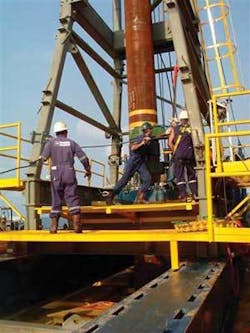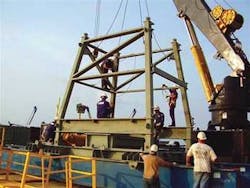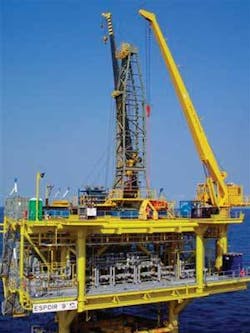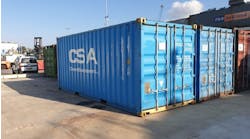Alternative for extracting and pre-installing conductors
Andy Elliott, David Harris - BJ Tubular & Completion Assembly Services
With rigs becoming increasingly scarce, operators are forced to delay abandonment and drilling plans for weeks, even months. For operators with the foresight to anticipate this shortage, an environmentally friendly hydraulic rigless intervention system (RIS) is available as a means of extracting and pre-installing conductors without a rig.
Running conductor with BJ’s RIS on Espoir B offshore Cote d’Ivoire for CNR.
BJ Tubular Services’ RIS has performed for a number of operators in the Gulf of Mexico. The system reduces the time and expense associated with installing conductors by pre-installing them prior to the arrival of the drilling rig, using the RIS to handle and drive them with hydraulic hammers. On the conductor extraction side, the system speeds the process of abandoning multiple wells on fixed platforms.
Modular mini-derrick
The system operates like a modular mini-derrick. It can be disassembled into sections that can be transported by truck and by average-size supply vessels. The sections are small enough so that a platform crane can easily lift them from a boat and assemble the system on the platform. Once set up, it performs tasks similar to those of a drilling rig - lifting, pulling, driving and running pipe. It can have a power swivel installed to extend the capabilities for well intervention purposes. The greatest economic benefit of the system is that it can be rented for a fraction of the cost of an average rig. Another advantage is that it is much lighter than a conventional workover rig.
Day 1-Prior to rigging-up, the main deck of Espoir B shows the 12 slots waiting for conductor installation. Not much room to maneuver in this limited space.
In the GoM alone, there are approximately 4,000 platforms that eventually must be abandoned and removed, in accordance with Minerals Management Service requirements. In view of this, the company recognized a gap in the market for a more efficient means of carrying out this necessary process. Traditionally, service companies have relied upon casing jacks to remove the conductors when abandoning a well. The RIS performs better than casing jacks when removing conductors. Casing jacks can only pull 10-ft sections of conductors, and because they grip the outer wall of the conductor, sea growth must be stripped from the conductor to prevent slippage, making them more time-consuming to use.
Dismantling process
The system includes a mast that measures 76 ft and a split block that is capable of lifting 250 tons. It can handle pipe measuring up to 36 in. diameter, with all inner strings cemented inside the conductor. Also it can remove 50-ft conductor sections at a time, which speeds the dismantling process. By pinning the conductor section and lifting it with slings, less time is required to carry out the extraction process by enabling 50-ft sections to be cut and laid out.
GoM conductor extraction
During well abandonment, the system mounts on the beams of the platform. After the well has been plugged, a multi-string internal cutter is run to make the first cut, which must be at least 15 ft below the mudline. Then, in conjunction with the pinning process, a guillotine saw cuts the 50-ft sections, which are then laid out on the deck for transport and disposal.
During the past year, the system successfully abandoned a number of wells for operators in the GoM. Most recently, a well abandonment operation for Chevron on the Garden Banks 191 platform resulted in the company extracting 10 conductors without using a rig.
An innovative swivel system was developed to overcome problems associated with pulling through undersize bell guides. The company used the bowl and slips to hold the pipe before installing the pins. The system was then used to pick up the 50-ft joints.
Day 4 - By day 4, the RIS is ready to pick up and run the first conductor.
In recent months, the system extracted 15 conductors for a major operator in the GoM in the South Marsh Island area.
The estimated timesaving with the system exceeded 1.25 days per well, resulting in reduced costs per well compared to conventional jacking systems.
“We are very excited about the benefits realized recently by the industry in the GoM, as a direct result of using the Rigless Intervention System,” said Kenny Watt, division manager of BJ Tubular Services. “Its successful performance in the field demonstrates the system’s ability to reduce the amount of time required to abandon a well in a safe and environmentally friendly manner. For operators faced with the prospect of abandoning thousands of wells around the world during the next 20 years, the long-term savings of time and money is truly significant.”
Pre-installing conductors
Recently, the company mobilized the system to pre-install a number of conductors offshore Cote d’Ivoire, Africa, a first for the region. The challenging operation was carried out for CNR International (Cote d’Ivoire) S.A.R.L., a subsidiary of Canadian Natural Resources. This particular operation was the first time that the company has pre-installed conductors with the system in Cote d’Ivoire.
The million-dollar contract called to pre-install 12 conductors and supply cold cutting services on CNR’s West Espoir wellhead tower located offshore Abidjan.. Using the system, directional drive shoes and the hydraulic S90 Hydrohammer, the company’s hammer services specialists started operations in early December 2005. Working in depths of more than 400 ft (440 ft mudline penetration), the operation was completed by the Dec. 29, 10 days ahead of schedule.
“To put it in perspective, the rigless operation will accelerate CNR’s oil production by approximately 20 days. By the time the rig arrives, the conductors already will be driven, saving 20 days rig time,” said Watt. “By completing this operation with the system instead of a costly rig, CNR realized an incredibly impressive cost-savings.”
The operation was carried out with a team of 13 personnel and state-of-the-art equipment. Hammer conductor-driving equipment was supplied by its base in Great Yarmouth, England, and the system was mobilized from its facility in Lafayette, Louisiana.
Additional uses
In addition to pre-installation and abandonment of conductors, the system provides an alternative means of providing a number of offshore operations, as follows:
- Slot reclamation on platforms
- As an alternative on TLPs and spar platforms when pulling production risers and tubulars
- When fitted with a power swivel, it can be used as an alternative to a workover rig for sidetrack, whipstock and other operations.
The system became a central feature of the company’s hammer services portfolio in 2003. With a history of 30 years in this business, its operations have included hundreds of single slot hammer conductor and caisson-driving operations worldwide.
Looking ahead
With the acute shortage of rigs, particularly jackups, and an increasing number of multi-well platforms scheduled for abandonment in the Arabian Gulf, Southeast Asia, and West Africa, a greater demand for conductor pre-installation and abandonment operations will be needed around the world.







